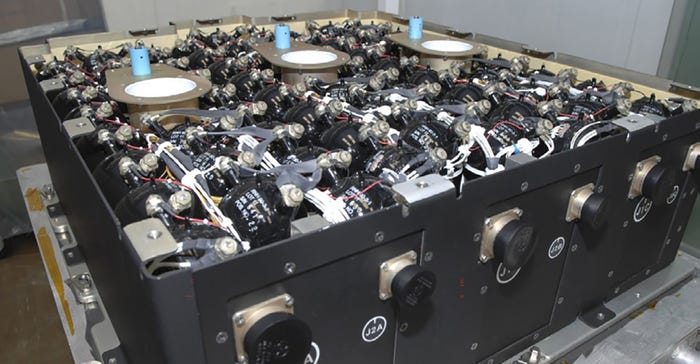Do Satellites Run Out of Power?
Satellites spend part of their orbits in the Earth's shadow; some need to rely on energy storage to keep their electronic systems operating.

Satellites have solar panels that convert the Sun’s energy into electricity. Most of the time satellites can function on solar energy but when the latter is not available, satellites can be powered from batteries to provide an uninterrupted coverage.
Satellite power system can use primary and secondary batteries. For short missions, primary batteries are more commonly used, and they are not rechargeable. But for more-distant missions, where satellite do not get enough direct solar energy, secondary batteries work better since they are rechargeable—they can be recharged when the satellite's orbit brings it back into sunlight.
Batteries powering satellites must stand conditions that normally harm conventional batteries, and they should meet the following characteristics:
Have very high energy density
Withstand extreme temperature fluctuations
Have long life span
Be tough enough to survive high shock, vibration, and radiation environments
Types of batteries used for satellites in space
Nickel-cadmium (Ni-Cd) batteries
Approximately four decades ago, nickel-cadmium batteries (Ni-Cd) were regularly used in Low Earth Orbit (LEO) satellites and Geosynchronous Earth Orbit (GEO) satellites. The technology behind the Ni-Cd battery has been around for decades and it is a mature technology capable of delivering full capacity with a high discharge rate. Although Ni-Cd batteries were not very energy-dense, they were inexpensive, and they were considered lightweight. But they have weaknesses too—high charging rates can cause overcharging and overheating. Their usage has declined in recent years in favor of other types of battery chemistries. Here are some examples of satellites that have used Ni-Cd batteries in the past:
Landsat 7: This was launched on April 15, 1999. Its primary goal was to refresh the global archive of satellite photos, providing up-to-date and cloud-free images. Power is provided by a single Sun-tracking solar array and two 50-Ah (Ampere-Hour), Ni-Cd batteries.
Geostationary Operational Environmental Satellites (GOES) series: They were launched in the 1970s. These satellites support weather forecasting, severe storm tracking, and meteorology research. Originally, they carried two Ni-Cd batteries. Each battery with 28 cells with a 12-Ah capacity, provided the satellite power needs during the ascent phase and during the semi-annual eclipse seasons lasting for approximately 45 days each. The maximum duration eclipses are 72 minutes long which result in a 60% depth of discharge (DOD).

Nickel-hydrogen (NiH2) batteries
NiH2 battery technology has been used highly for satellite applications. They were developed to increase energy density and capacity in rechargeable battery technology for aerospace energy storage. The NiH2 cells are a hybrid technology, combining elements from both batteries and fuel cells. They utilize the nickel hydroxide electrode from Ni-Cd cells and a platinum hydrogen electrode from fuel cell technology to create a chemistry without the issues and limitations inherent with the cadmium electrode. NiH2 batteries have better long-term cycle life and specific energy over the standard aerospace Ni-Cd batteries, even though they have a poorer volumetric energy density.
Here are some examples of satellites that have used NiH2 batteries:
Hubble Space Telescope: It was launched into low Earth orbit in 1990 and remains in operation. It allows astronomers to make the very high resolution observations that are essential to open new windows onto planets, stars, and galaxies. Hubble’s six batteries are each constructed of twenty-two NiH2 cells. Designed to be replaced by astronauts, the batteries are contained in two modules that hold three batteries apiece. Hubble’s first set of batteries lasted 19 years. The spacecraft is now on its second set of batteries, installed in 2009 during Servicing Mission 4.

Mars Global Surveyor (MGS): It was launched in 1996 and it was designed to study the composition of Mars, map its topography, and monitor weather patterns. Energy was stored in two 20-Ah NiH2 batteries.
Lithium-ion (Li-Ion) batteries
Lithium-ion batteries are commonly use nowadays in space applications since they significantly reduce the weight of equipment. These batteries can provide higher energy levels and longer cycle life at a lower weight than Ni-Cd or NiH2 batteries.
Here are some examples of satellites that have used Li-Ion batteries:
Copernicus Sentinel 1: It was launched in 2014. Land and sea monitoring, natural disasters mapping, sea ice observations, ships detection and it is power by 324-Ah Li-Ion battery.
EUMETSAT third-generation weather satellites: The first satellite entered operation in 2022. Its purpose is to monitor weather, climate, and the environment from space. The satellite contains Saft’s VES16 batteries power continuity during periods of up to 72 minutes per day when the Earth eclipses the Sun, pausing power generation from the solar photovoltaic panels.

As space-battery technology continue to advance, it enables the development and launch of more advanced and capable satellites. These advances have also led to the development of smaller satellite and improved global communications, but it has also presented challenges related with space debris.
About the Author(s)
You May Also Like





